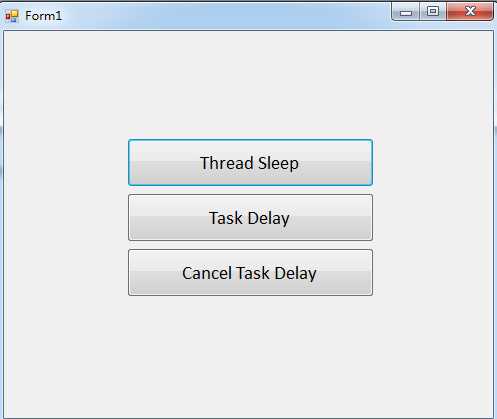We use both Thread.Sleep() and Task.Delay() to suspend the execution of a program for some given time. But are we actually suspending the execution? What is the difference between these two? How to abort from a Sleeping thread or from a delaying task. Those are some of the questions I believe most of us have. Hopefully I am trying to answer all the questions above.
Let’s go by an example. I have a very simple windows forms application which has the following form.
I have the following two basic helper methods and I am calling these two methods from my “Thread Sleep” and “Task Delay” button.
void PutThreadSleep()
{
Thread.Sleep(5000);
}
async Task PutTaskDelay()
{
await Task.Delay(5000, tokenSource.Token);
}
private void btnThreadSleep_Click(object sender, EventArgs e)
{
PutThreadSleep();
MessageBox.Show("I am back");
}
private async void btnTaskDelay_Click(object sender, EventArgs e)
{
await PutTaskDelay();
MessageBox.Show("I am back");
}
asically there is nothing to describe about the code up there (I am not going to explain what async and await here, you can find many articles in MSDN and one of my
previous post explaining async/await). When I clicked both these buttons, the message boxes will be displayed after 5 seconds. But there are significant differences between these two ways. Let’s find out what.
Thread.Sleep()
This is the classical way of suspending a execution. This method will suspend the current thread until the elapse of giving time.When you put the Thread.Sleep in the above way, there is nothing you can do to abort this except by waiting till the time elapses or by restarting the application. That’s because this suspends the main thread the program is running. And because of that the UI is not responsive.
Task.Delay()
When comparing to Thread.Sleep(), Task.Delay() acts in a different way. Basically Task.Delay() will create a task which will complete after a time delay. This task will be running in a different thread, UI is responsive, and that‘s because Task.Delay() is not blocking the main thread.
Behind the scene what is happening is there is a timer ticking till the specified time. Since there is a timer, anytime we can cancel the task delay by stopping the timer. To cancel, I am modifying the above PutTaskDelay() method as follows.
CancellationTokenSource tokenSource = new CancellationTokenSource();
async Task PutTaskDelay()
{
try
{
await Task.Delay(5000, tokenSource.Token);
}
catch (TaskCanceledException ex)
{
}
catch (Exception ex)
{
}
}
Here when the task got cancelled, it will be throwing me a TaskCanceledException. I am just catching the exception and suppressing it, because don‘t want to show any message about that.
So in my “Cancel Task Delay” button click event, I am asking the task to be cancelled.
private void btnCancelTaskDelay_Click(object sender, EventArgs e)
{
tokenSource.Cancel();
}
Once the task has been cancelled, the control returns immediately to the next line and message box will be shown.
https://code.msdn.microsoft.com/ThreadSleep-vs-TaskDelay-766b46b7

~7F9TGWWHT`]6.png)